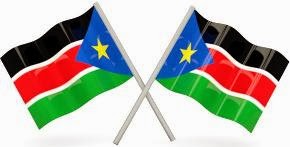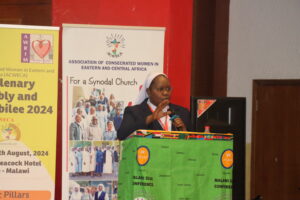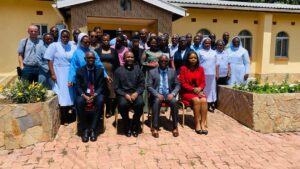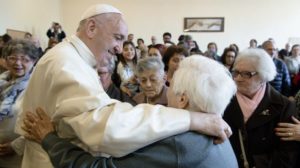SOUTH SUDAN: The Country still recuperating from Ethnic Tensions

The
rich Oilfield in Greater Upper Nile Region in northern and eastern South Sudan,
which is constituted by Unity State, Upper Nile State and Jonglei State, is one of the
most affected area in the ongoing conflict in South Sudan.
rich Oilfield in Greater Upper Nile Region in northern and eastern South Sudan,
which is constituted by Unity State, Upper Nile State and Jonglei State, is one of the
most affected area in the ongoing conflict in South Sudan.
Unity
State oilfield, where the great Nile Oil Pipeline comes from, is within the largest hydrocarbon accumulation in the Muglad
rift basin and contains an estimated 150,000,000 barrels (24,000,000 m3) of
oil.
State oilfield, where the great Nile Oil Pipeline comes from, is within the largest hydrocarbon accumulation in the Muglad
rift basin and contains an estimated 150,000,000 barrels (24,000,000 m3) of
oil.
Reports
accessed by AMECEA Online News reveal
that the Greater Upper Nile Region which also includes the Diocese of Malakal has
been experiencing devastating effects of the armed conflicts and violence up to now. Information from various News
agencies indicates that there are still some pocket of government resistance
and attacks in the region.
accessed by AMECEA Online News reveal
that the Greater Upper Nile Region which also includes the Diocese of Malakal has
been experiencing devastating effects of the armed conflicts and violence up to now. Information from various News
agencies indicates that there are still some pocket of government resistance
and attacks in the region.
The
conflict which originated in Juba in December 2013 quickly spread to Unity,
Upper Nile and Jonglei states. These three States apparently are inhabited predominantly
by two ethnic groups, the Nuer (majority) and the Dinka (minority). That is why
the conflict turned ethnic. (Jonglei was
the state where so called the opposition leaders took control of Bor, the
capital of Jonglei state). What followed were massacres of innocent people
who had nothing to do with the power struggle between the political leaders.
conflict which originated in Juba in December 2013 quickly spread to Unity,
Upper Nile and Jonglei states. These three States apparently are inhabited predominantly
by two ethnic groups, the Nuer (majority) and the Dinka (minority). That is why
the conflict turned ethnic. (Jonglei was
the state where so called the opposition leaders took control of Bor, the
capital of Jonglei state). What followed were massacres of innocent people
who had nothing to do with the power struggle between the political leaders.
Since
then, Bor town has changed hands four times, between the government forces and
the rebels; record Malakal, the capital of Upper Nile state, is yet to level or
break. The violence that raged through Bor left many people, most of them
civilian, dead and others forced away from their homes.
then, Bor town has changed hands four times, between the government forces and
the rebels; record Malakal, the capital of Upper Nile state, is yet to level or
break. The violence that raged through Bor left many people, most of them
civilian, dead and others forced away from their homes.
The
conflict in these three states, Jonglei, Unity State whose capital is Bentiu
and Upper Nile State whose capital is Malakal continue to affect the civilians despite
peace talks being held in Ethiopia and Ceasefire signed.
conflict in these three states, Jonglei, Unity State whose capital is Bentiu
and Upper Nile State whose capital is Malakal continue to affect the civilians despite
peace talks being held in Ethiopia and Ceasefire signed.
The
City of Malakal is completely destroyed and so as Bentiu. Unity, Jonglei and
Upper Nile States are rich in oilfield therefore the conflict between the
government forces and the rebels seem to be over the controls.
City of Malakal is completely destroyed and so as Bentiu. Unity, Jonglei and
Upper Nile States are rich in oilfield therefore the conflict between the
government forces and the rebels seem to be over the controls.
South
Sudan is divided into 10 states. They were created out of the three historic
former provinces (and contemporary regions) of: Bahr el Ghazal (northwest);
Equatoria (southern), and Greater Upper Nile (northeast). The states are
further divided into 86 counties.
Sudan is divided into 10 states. They were created out of the three historic
former provinces (and contemporary regions) of: Bahr el Ghazal (northwest);
Equatoria (southern), and Greater Upper Nile (northeast). The states are
further divided into 86 counties.
The
ten states of South Sudan are grouped in the three historic regions namely
ten states of South Sudan are grouped in the three historic regions namely
·
Bahr el Ghazal (Western Bahr el Ghazal State, Northern Bahr
el Ghazal State, Warrap State and Lakes State)
Bahr el Ghazal (Western Bahr el Ghazal State, Northern Bahr
el Ghazal State, Warrap State and Lakes State)
·
Equitorial (Western EquitoriaState, Central Equitoria State
and Eastern Equitoria State)
Equitorial (Western EquitoriaState, Central Equitoria State
and Eastern Equitoria State)
·
Greater Upper Nile (Unity State, Upper Nile State and
Jonglei State)
Greater Upper Nile (Unity State, Upper Nile State and
Jonglei State)
The
State capital of Central Equatoria, the smallest South Sudanese state by area,
is Juba, which also serves as the Capital of South Sudan.
State capital of Central Equatoria, the smallest South Sudanese state by area,
is Juba, which also serves as the Capital of South Sudan.
“Despite
the fact that other states are not affected by the conflict, the effect of the
conflict is felt throughout South Sudan”, says one of the Catholic Nuns from Lake
State who was in Nairobi for Training Workshop Organized by Association of
Consecrated Women in Eastern and Central Africa (ACWECA).
the fact that other states are not affected by the conflict, the effect of the
conflict is felt throughout South Sudan”, says one of the Catholic Nuns from Lake
State who was in Nairobi for Training Workshop Organized by Association of
Consecrated Women in Eastern and Central Africa (ACWECA).
Speaking
to AMECEA Online News, the nun who opted to remain anonymous said that it is a
heart breaking situation witnessing internally displaced people who have fled
from their homes to other States. “These people are very vulnerable, they require shelter, food
and other necessities which the humanitarian organizations and well wishers
cannot fully provide for. The most affected are pregnant women, small children
and the elderly,” she said.
to AMECEA Online News, the nun who opted to remain anonymous said that it is a
heart breaking situation witnessing internally displaced people who have fled
from their homes to other States. “These people are very vulnerable, they require shelter, food
and other necessities which the humanitarian organizations and well wishers
cannot fully provide for. The most affected are pregnant women, small children
and the elderly,” she said.
Source: AMECEA
Social Communications
Social Communications


